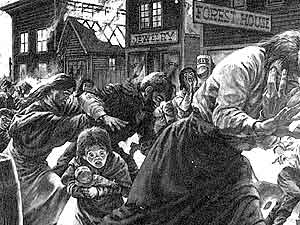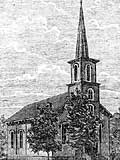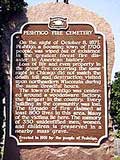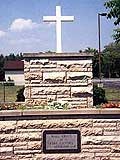Peshtigo: a tornado of fire revisited
November 27, 2002
 |
| Artist's conception of residents of Peshtigo running down Oconto Ave. toward the protection of the river. (Image courtesy of Wisconsin Electronic Reader) |
School children in Wisconsin learn about the Peshtigo Fire, but most people don't know anything about it. That could change, as readers discover two new books on the subject.
Duluth, Minn. — In 1871, Peshtigo was a small town nestled on the Peshtigo River, which flows into Green Bay. It was just like other mill towns across Michigan, Wisconsin, and Minnesota.
Lumberjacks cut the trees and left the branches in huge tangles in the woods. Millworkers sawed the logs and made great piles of slabs and sawdust. Settlers burned the stumps to clear land for farming. And the men clearing a route for the new railroad burned whatever was in their way.
1871 was a very dry year
 | |||
"There were fires burning all summer and into the fall," says Peter Leschak. He is the author of Ghosts of the Fireground, a reflection on the Peshtigo Fire and his own experiences of firefighting.
"Slash-and-burn agriculture, land clearing, the railroad guys clearing line. And nobody put out fires in those days," Leschak says.
During the week before the fire, the air was so filled with smoke that harbormasters on Lake Michigan blew their foghorns constantly to keep ships from running aground. But still, people saw fire as a good thing.
Denise Gess is the co-author with William Lutz of Firestorm at Peshtigo, a detailed history of the disaster. She says the farmers in the region set fires to get rid of trees and stumps so they could plant.
"Even the immigrants who came from Belgium, Norway, Sweden, Germany -- they knew this is how you clear land. They saw fire as an ally," says Gess.
People were used to fires, even when they got out of control. But Peter Leschak says no one was prepared for what happened at Peshtigo that day.
"The big trees they were cutting were red pine and white pine. And when that stuff gets to be red slash -- as it's called when it dries out -- it's incredibly volatile."
Leschak says all the ingredients of a major disaster came together on Oct. 8, 1871.
 | |||
A tornado of flame
"A huge cyclonic low system -- a cold front -- came sweeping in from the western part of the country," Leschak says.
The difference in temperature on each side of the cold front was probably 40 degrees. That set up furious winds that fanned prairie fires all over the region. Fires were burning all over, from Chicago north to Michigan, and as far west as Minnesota.
"And basically at one point or another, several small fires join into one huge fire," says Leschak. "It becomes more or less stationary over Peshtigo, and why there I'm not sure. Perhaps, with all the buildings -- any building is just another fuel arrangement -- so you had a very tightly arranged fuel in the town itself."
The blazes developed into a firestorm. The heat generated by the burning trees and buildings caused a column of hot air to rise over the town. Cold air rushing in to take its place fanned the flames. That caused more hot air to rise.
 | |||
The town was at the center of a tornado of flame. The fire was coming from all directions at once, and the winds were roaring at 100 mph.
Some people in Peshtigo managed to struggle to the river. A Catholic priest arrived at the river and found people standing on the banks. He pushed one of them into the water, and the rest followed. They stood in the water for hours. Some of them survived.
Leschak says at the center of the fire, the vortex of wind sucked the smoke up into the sky, so the air was clear and bright with flame. He says the people in the river experienced "something that very few people have ever witnessed, and lived to tell the tale. They're at the center of this hurricane of flame. Small wonder their hair was bursting into flame if they didn't keep ducking their heads into the water. And to have survived that is just amazing, just amazing," Leschak says.
Most people weren't so lucky. Karl Lamp and his wife were German immigrants who were trying to build a farm. Denise Gess says when she was researching her book, she came to think of this couple as representing the fortitude of immigrant settlers, and the heartbreak they faced.
"This man saved up all of his money to have his 40 acres," Gess says. "He finally gets them cleared. She's working at the Peshtigo Woodenware factory and he's out there clearing stumps. She was pregnant with their fourth child when the fire struck."
The whole family escaped from the house and got in their wagon.
 | |||
"And they thought they could run for it, but you can't run from a fire that's moving that quickly," says Gess. "The wagon wheel fell off and he saw the family was still safe. Then the horse went up in flames. He turned around for a second and turned back, and there was his whole family, in flames."
Leschak says the ambient air temperature was probably between 500 and 700 degrees.
"Which means that they weren't going to live very long anyway," says Leschak. "If your clothes are bursting into flame, you are also doing extreme damage to your respiratory tract. I think there was a lot of intense pain that went on. And I think that's why, for example, there's the account of the one man who slit the throats of all his children to spare them this death by fire."
The fire went out when it had burned up everything in Peshtigo. The survivors rebuilt the town, but it wasn't a booming mill town anymore. The trees were gone.
Too rich to quit
But that wasn't the end of the monstrous fires.
 | |||
As the lumber camps and railroads and settlers moved west, the fires moved with them. In Minnesota there were several major fires. In 1894, a fire in Hinckley killed 400 people, and in 1918 the Cloquet fire killed more than 500 people.
Leschak says the fires continued as long as there were trees to turn into lumber.
"They weren't going to stop the practices that were making them rich. Simple as that," says Leschak. "It wasn't worth it to them to treat the slash, to log in a way that would not create such fuel. And essentially, that era ended when all the big timber was gone."
The Peshtigo fire was horrific. But many years later, scientists tried to recreate it. During World War II, the U.S. military studied the Peshtigo Fire to learn how to make firestorms.
And then they made them, by dropping thousands of tons of bombs on Dresden and Tokyo. More people died in those cities than died in Hiroshima when the atomic bomb fell.
"They actually made a 'demo' first," Gess says, "a little scale model of wooden buildings, and studied how you would drop bombs until it created a firestorm. Something that devastating and that hot."
Denise Gess is co-author with William Lutz of Firestorm at Peshtigo. Peter Leschak is author of Ghosts of the Fireground.
|
News Headlines
|
Related Subjects
|
